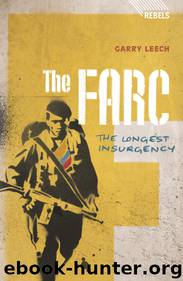The FARC by Leech Garry

Author:Leech, Garry
Language: eng
Format: epub
Publisher: Zed Books
Published: 2011-11-05T16:00:00+00:00
The Oil Factor
US support for Uribe was evident not only in the rhetoric of Bush administration officials, but also in the provision of counter-terrorism aid. In the same manner that the FARC’s fighters were labelled ‘narco-guerrillas’ and became the principal target of Plan Colombia under the guise of Washington’s war on drugs, the term ‘narco-terrorists’ was regularly applied to the rebels following 9/11 and they immediately became the principal target of the US war on terror in Colombia. And, as also had occurred with Plan Colombia, an increase in US military aid – this time counterterrorism aid – coincided with an IMF loan to Colombia. In January 2003, the IMF authorized a two-year, $ 2.1 billion loan to the South American nation; the same month, US Army Special Forces soldiers arrived in the oil-rich department of Arauca.
The Uribe government fulfilled the neoliberal conditions attached to the IMF loan by completing the transformation of the country’s oil regime. In 1999, prior to both the first IMF loan and Plan Colombia, foreign corporations operating in Colombia’s oil sector were required to enter into a 50–50 partnership with the state oil company Ecopetrol. They were also required to pay a 20 per cent royalty rate on their share of the oil extracted and obligated to give up their rights to a productive field after twenty-two years. By 2004, foreign companies no longer had to enter into partnership with Ecopetrol; they could own 100 per cent of the oil in a field to which they owned the concession. Furthermore, the royalty rate had been reduced to only 8 per cent in most cases and companies held the rights to the oil for the life of the field.42
But while IMF economic reforms had created favourable investment conditions for multinational oil companies, there still existed the problem of security on the ground. Many of Colombia’s oil reserves were situated in rural regions dominated by the guerrillas. Plan Colombia had provided security for companies operating in oil-rich Putumayo in southern Colombia, which was also a principal coca-growing region. The implementation of Plan Colombia in Putumayo had followed on the heels of a dramatic increase in the number of attacks against the department’s oil infrastructure from 48 in 1999 to 110 the following year. The growing military strength of the FARC in Putumayo during the 1990s had made foreign oil companies hesitant to exploit the vast oil reserves that mostly existed in rebel-controlled regions.
The situation changed with the arrival of AUC paramilitaries in the late 1990s and the implementation of Plan Colombia in 2000, both of which resulted in greater security for oil operations. According to the Colombian army commander responsible for protecting Putumayo’s oil operations, Lieutenant Colonel Francisco Javier Cruz, US drug war aid made the region safer for conducting oil operations because the army was able to use ‘helicopters, troops and training provided in large part by Plan Colombia’.43 Since 2004, the Colombian government has signed dozens of contracts with foreign oil companies providing them with the rights to exploit the oil in Putumayo.
Download
This site does not store any files on its server. We only index and link to content provided by other sites. Please contact the content providers to delete copyright contents if any and email us, we'll remove relevant links or contents immediately.
| Argentina | Bolivia |
| Brazil | Chile |
| Colombia | Ecuador |
| Guyana | Paraguay |
| Peru | Suriname |
| Uruguay | Venezuela |
Cat's cradle by Kurt Vonnegut(15252)
Pimp by Iceberg Slim(14433)
4 3 2 1: A Novel by Paul Auster(12329)
Underground: A Human History of the Worlds Beneath Our Feet by Will Hunt(12050)
The Radium Girls by Kate Moore(11970)
Wiseguy by Nicholas Pileggi(5706)
The Fire Next Time by James Baldwin(5379)
Perfect Rhythm by Jae(5354)
American History Stories, Volume III (Yesterday's Classics) by Pratt Mara L(5274)
Paper Towns by Green John(5136)
Pale Blue Dot by Carl Sagan(4950)
A Higher Loyalty: Truth, Lies, and Leadership by James Comey(4904)
The Mayflower and the Pilgrims' New World by Nathaniel Philbrick(4456)
The Doomsday Machine by Daniel Ellsberg(4447)
Killers of the Flower Moon: The Osage Murders and the Birth of the FBI by David Grann(4406)
The Sympathizer by Viet Thanh Nguyen(4336)
Too Much and Not the Mood by Durga Chew-Bose(4301)
The Borden Murders by Sarah Miller(4273)
Sticky Fingers by Joe Hagan(4142)
